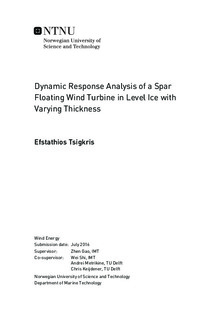| dc.description.abstract | This master thesis is the final step before graduation from the Offshore Engineering track of the European Wind Energy Master. Both the Diploma award universities contributed significantly in the completion if this work by excellent supervision.
The graduation project consists of the dynamic response analysis of a spar floating wind turbine in level ice with varying thickness. This topic is important in the field of renewable energies given the fact that wind energy is known as the fastest growing renewable energy. In the case of regions with cold climates, ice loads become significant and have to be taken into account when designing and offshore structure like an offshore wind turbine.
Relevant literature study was examined in order to establish a theoretical background regarding ice properties, formulation of level ice, variation of ice thickness, ice loads on conical structures, ice failure mechanisms, numerical modelling and dynamic response analysis of a spar floating wind turbine.
As soon as this basic knowledge is founded, a set of existing measurements of level ice was used in order to formulate a random varying thickness ice field. This field was implemented considering the 2D case meaning that the ice thickness varied along the path of the contact with the spar wind turbine.
The greatest challenge came up when the existing model needed to be modified in order to account for the variation in thickness. This was accomplished by modelling the ice floe as an Euler - Bernoulli beam of varying cross - section assuming linear variation of ice between each space interval. The stress distribution along the beam s length was obtained and as a result the behaviour of the ice floe at each cross - section is investigated and analysed.
This new model was implemented in FORTRAN as a DLL file and coupled to HAWC2 in order to simulate the behaviour of the spar floating wind turbine in the varying thickness level ice environment.
The results obtained generally revealed a decrease in the ice loads when a varying ice field is considered. Moreover, it is observed that the varying ice thickness field introduces a more dynamic effect on the structure, especially for the low drifting speeds. As soon as aerodynamic loads are also included, then it is also noticed that the combined wind and ice loads, give rise to frequencies different from the ones only the ice loads excite. | |

